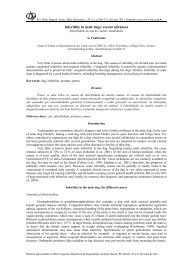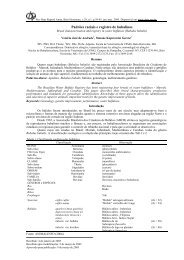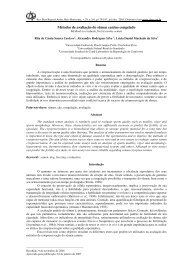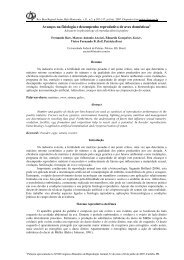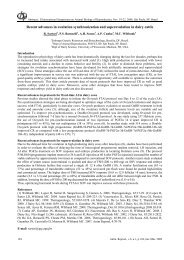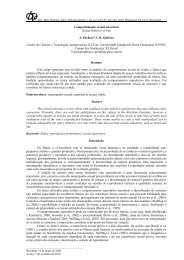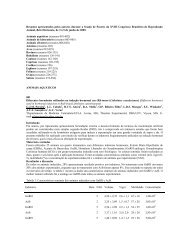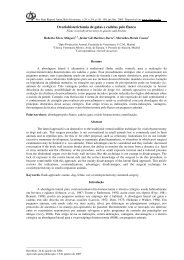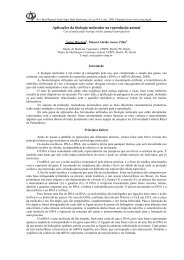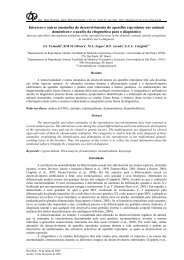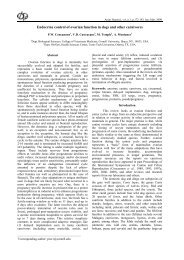Sanitary requirements for bovine gametes and embryos in ... - CBRA
Sanitary requirements for bovine gametes and embryos in ... - CBRA
Sanitary requirements for bovine gametes and embryos in ... - CBRA
Create successful ePaper yourself
Turn your PDF publications into a flip-book with our unique Google optimized e-Paper software.
Ponsart <strong>and</strong> Pozzi. <strong>Sanitary</strong> <strong>requirements</strong> <strong>for</strong> <strong>gametes</strong> <strong>and</strong> <strong>embryos</strong>.Table 5. Assessment of the sanitary risk <strong>for</strong> <strong>in</strong> vivo derived <strong>embryos</strong> us<strong>in</strong>g scientific approaches.In vivo <strong>in</strong>fectionIn vitro <strong>in</strong>fectionIn vivo embryotransfer• naturally <strong>in</strong>fected donor or <strong>in</strong>sem<strong>in</strong>ationwith <strong>in</strong>fected semen;••experimentally spiked <strong>embryos</strong>/semen;<strong>embryos</strong> transferred to recipients.In vitro embryowash<strong>in</strong>g• Embryos transferred to recipients.• naturally <strong>in</strong>fected donor or <strong>in</strong>sem<strong>in</strong>ationwith <strong>in</strong>fected semen;• embryo status analyzed after wash<strong>in</strong>gprocedure described <strong>in</strong> IETS Manual.• experimentally spiked <strong>embryos</strong>/semen;• embryo status analyzed after wash<strong>in</strong>gprocedure <strong>in</strong> IETS Manual.Concern<strong>in</strong>g transmission risk via ET, the IETSHASAC Committee reviews scientific publications onan annual basis <strong>and</strong> updates a complete set of more than400 references, which can be consulted on their website(www.iets.org). In the <strong>bov<strong>in</strong>e</strong> species, 89 potentialembryo pathogens have been <strong>in</strong>vestigated (Thibier,2011). All diseases <strong>and</strong> pathogenic agents have beenplaced <strong>in</strong>to one of four categories based on the amountof research <strong>in</strong>dicat<strong>in</strong>g the likelihood of disease controlthrough the use of embryo transfer (Table 6). Forcategory 1 diseases, risk of transmission of a givendisease from donor to recipient via an embryo isnegligible, provid<strong>in</strong>g biosecurity measures described<strong>for</strong> h<strong>and</strong>l<strong>in</strong>g <strong>embryos</strong>, material dis<strong>in</strong>fection, <strong>and</strong> animalhealth <strong>requirements</strong> (semen, donor, <strong>and</strong> recipients ) asdescribed <strong>in</strong> the IETS Manual have been respected(Str<strong>in</strong>gfellow, 2010; Thibier, 2011).New questions have been raised regard<strong>in</strong>gtryps<strong>in</strong> treatments: Al Ahmad et al. (2012) compared atreatment st<strong>and</strong>ard (TS) comprised of phosphate-bufferedsal<strong>in</strong>e (PBS), 0.4% BSA (five washes of 100 fold dilution<strong>for</strong> 10 sec each), followed by two treatments with 0.25%tryps<strong>in</strong> <strong>in</strong> Hank’s solution (45 sec each), <strong>and</strong> then PBS0.4% BSA aga<strong>in</strong> (five times <strong>for</strong> 10 sec). The four otherwash<strong>in</strong>g procedures all <strong>in</strong>cluded the same first <strong>and</strong> lastwash<strong>in</strong>g steps with PBS but without BSA (five times <strong>for</strong>10 sec) <strong>and</strong> with PBS 0.4% BSA (five times <strong>for</strong> 10 sec),respectively. The <strong>in</strong>termediate step varied <strong>for</strong> each wash<strong>in</strong>gprocedure, with other tryps<strong>in</strong> treatments (longer time, twice<strong>for</strong> 60 sec) or hyaluronidase treatments <strong>in</strong> order toelim<strong>in</strong>ate Blue tongue virus (BTV) from <strong>in</strong> vitro <strong>in</strong>fectedgoat <strong>embryos</strong>: only two tryps<strong>in</strong> treatments of 60 sec eachwas effective <strong>in</strong> remov<strong>in</strong>g BTV from the <strong>embryos</strong>.Legal <strong>and</strong> sanitary measures applied to <strong>in</strong> vivoderived <strong>embryos</strong>Practical guidel<strong>in</strong>es have been published <strong>in</strong> theManual of the International Embryo Transfer Society <strong>in</strong>order to provide risk management procedures ensur<strong>in</strong>gthe safety of ET (Str<strong>in</strong>gfellow, 2010). S<strong>in</strong>ce theseguidel<strong>in</strong>es have been adopted by the OIE, they are wellaccepted <strong>and</strong> implemented worldwide (OIE, 2012;Chapter 4.7). In Europe, legislation prescribes thesanitary conditions to which embryo collection <strong>and</strong>transfer should comply. The Council Directive89/556/EEC of 25 September 1989 describes animalhealth conditions govern<strong>in</strong>g <strong>in</strong>tra-community trade <strong>in</strong><strong>and</strong> importation from third countries of <strong>embryos</strong> derivedfrom the <strong>bov<strong>in</strong>e</strong> species. The legislation def<strong>in</strong>es sanitary<strong>and</strong> biosecurity <strong>requirements</strong> <strong>in</strong>clud<strong>in</strong>g donor females,environmental <strong>and</strong> h<strong>and</strong>l<strong>in</strong>g conditions, <strong>and</strong> semen used<strong>for</strong> donor <strong>in</strong>sem<strong>in</strong>ation.• <strong>Sanitary</strong> <strong>requirements</strong>In addition to OIE recommendations (Table 7),EU legislation <strong>in</strong>cludes the follow<strong>in</strong>g <strong>requirements</strong>:donor cows must have spent the previous 6 monthswith<strong>in</strong> community territory or <strong>in</strong> the third country ofcollection <strong>in</strong> a herd officially tuberculosis <strong>and</strong> brucellosisfree, enzootic <strong>bov<strong>in</strong>e</strong> leucosis free (or no cl<strong>in</strong>ical signs ofenzootic <strong>bov<strong>in</strong>e</strong> leucosis dur<strong>in</strong>g the previous 3 years);<strong>and</strong> where no cl<strong>in</strong>ical signs of <strong>in</strong>fectious <strong>bov<strong>in</strong>e</strong>rh<strong>in</strong>otracheitis/<strong>in</strong>fectious pustular vulvo-vag<strong>in</strong>itis havebeen observed dur<strong>in</strong>g the previous year.• Environmental <strong>and</strong> h<strong>and</strong>l<strong>in</strong>g conditionsBoth the OIE Terrestrial Code (Chapter 4.7)<strong>and</strong> Directive 89/556 <strong>in</strong>clude biosecurity measures basedon a team approved by competent authority (governmentor local veter<strong>in</strong>ary authorities), supervised by a teamveter<strong>in</strong>arian responsible <strong>for</strong> all team operations (healthstatus of donor cows, appropriate disease control measureswith h<strong>and</strong>l<strong>in</strong>g <strong>and</strong> operat<strong>in</strong>g on donors, dis<strong>in</strong>fection, <strong>and</strong>hygiene procedures). Team personnel should be adequatelytra<strong>in</strong>ed <strong>in</strong> the techniques <strong>and</strong> pr<strong>in</strong>ciples of disease control.High st<strong>and</strong>ards of hygiene should be practiced topreclude the <strong>in</strong>troduction of disease.Procedures, facilities, <strong>and</strong> equipment are verifiedthrough regular official <strong>in</strong>spections (at least once a year)regard<strong>in</strong>g embryo collection, process, <strong>and</strong> manipulation of<strong>embryos</strong> at a permanent site or mobile laboratory, storageof <strong>embryos</strong> as well as activity records.The test<strong>in</strong>g of samples can be requested by animport<strong>in</strong>g country to confirm the absence of pathogenicorganisms that may be transmitted via <strong>in</strong> vivo derived<strong>embryos</strong> (see Table 9), or to assess the quality control ofthe collection team together with wash<strong>in</strong>g procedures.Specimens may <strong>in</strong>clude degenerated <strong>embryos</strong>, embryocollection fluids, <strong>and</strong> a pool of the last washes of the<strong>embryos</strong>. In the French regulations, this test<strong>in</strong>gprocedure is per<strong>for</strong>med annually <strong>in</strong> a central laboratory290 Anim. Reprod., v.10, n.3, p.283-296, Jul./Sept. 2013



